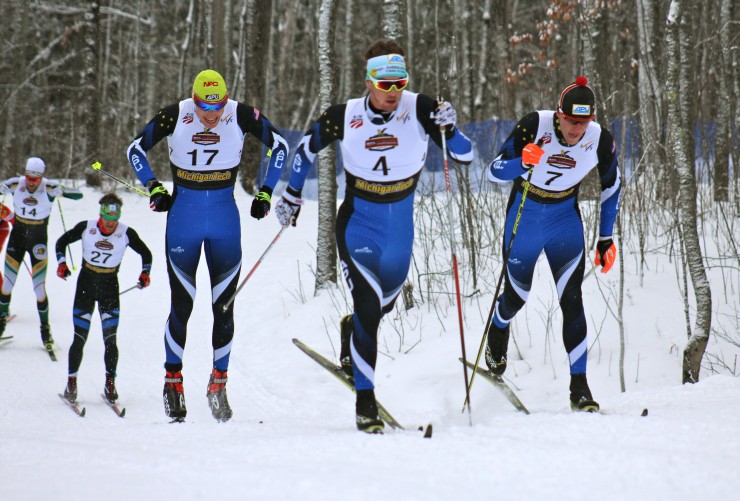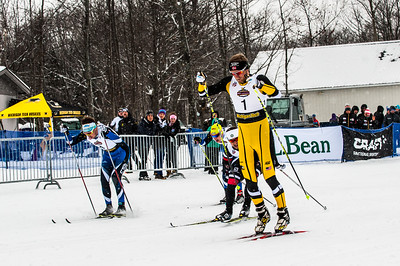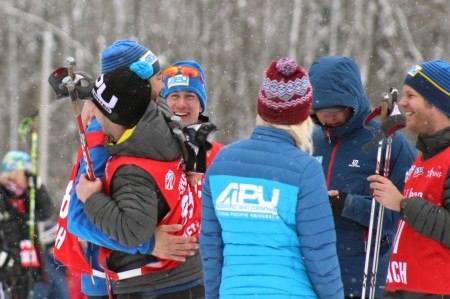
HOUGHTON, Mich. — The step into the reality of a goal is at times, long awaited. It is a step that Eric Packer of Alaska Pacific University (APU), the race winner of the men’s 1.5-kilometer classic sprint at U.S. Cross Country Championships on Saturday, feels he has finally made.
“I’ve dreamed of winning at nationals for a long time and to finally make it happen is really special,” said the 24-year-old during an in-person interview after winning his first U.S. nationals title on the Michigan Tech Trails. He had reached the national podium twice before: placing third in two races at 2012 nationals (classic sprint and 30 k classic mass start) in Rumford, Maine.
After racing to fourth overall in the 15 k classic individual start a week ago, then 11th in the freestyle sprint on the same course last Monday, and 25th in the 30 k freestyle mass start on Thursday, Packer remained receptive to any opportunity afforded him during Saturday’s sprint.
“The most challenging part for me was I was very tired after the qualifier,” said Packer. He qualified fourth, 4.74 seconds behind qualifying winner Didrik Fjeld Elset, a Michigan Tech freshman from Norway.
“It’s the accumulation of the week of racing and it’s hard to stay with it and remember that even though it’s the end of the week, it’s still a national championship,” Packer explained.
In the end, it was a challenge that left the Anchorage native unmatched in the final. To get there, Packer had won his quarterfinal and placed second his semifinal (behind Dakota Blackhorse-von Jess, of the Bend Endurance Academy) to automatically advance to the final.
“[APU] had a great day and that’s really cool for Eric to win,” Blackhorse-von Jess said after racing to fifth in the final, 5.37 second off Packer’s winning time of 3:38.17.
Along with Packer, APU’s Reese Hanneman and Tyler Kornfield also advanced to the final and placed second and fourth, respectively.

“My fiancé is trying on wedding dresses today, so I knew I had to win some money,” said Hanneman, the runner-up by 0.67 seconds. He got engaged last month.
Beyond bridal bouquets, Hanneman also now has World Cup starts ahead of him.
“I’m going to Europe [on Sunday] and I’ll race the sprints in Slovenia next weekend, all of Period 3,” said Hanneman, 26, also originally from Alaska. After that, he’s headed to Canada for the season-ending World Cup tour.
Overall third place finisher, Elset, 22, crossed 1.05 seconds after Packer, and explained he was seeking redemption after the skate sprint.
“I really wanted to do well today because I crashed in the semifinals on Monday,” Elset said.
Out of six hungry finalists in the men’s field, the contention for the title would prove challenging — especially with some racers on skate skis.
“I went with classic skis for the qualifier and then double poled all three heats,” Kornfield said. He finished fourth after Elset edged him in a photo finish for third. Both were given the same time.
Elset also double poled the final, after double poling the qualifier and his quarterfinal and semifinal as well.
“It was OK for the first three heats, but in the final when the guys were fast, my arms were really, really tired,” Elset said.
Hanneman and Blackhorse-von Jess took the opposite route, opting to race classic skis throughout the day.
Though another Norwegian, 23-year-old Håkon Hjelstuen, a former Michigan Tech skier, dabbled with double poling, he ultimately went with classic skis in the final.
“I tried it in the semis. It’s kind of a game,” Hjelstuen said after placing sixth overall, 24 seconds behind Packer.
Figuring that most racers would use skate skis during the quarterfinals and then switch to classic skis in the semi, Hjelstuen hoped to catch other competitors off guard.
“I thought, ‘OK, the other guys are probably doing it in their quarters and then maybe switching,’ so I was trying to switch the other way,” the Norwegian explained.
Also hoping to gain more control over his heats, Kornfield reasoned he made the right choice to double pole through the rounds.
“All my heats had mixtures of skate skis and classic skis so the downhills; it was obvious who could take the turns better,” Kornfield said. “Because I could take better lines than the classic skiers, I was able to choose where I wanted to go.”

The light snowfall, track traffic during rounds, along with the course’s lengthy climb to the finish, made decisions on ski choice largely up to the individual.
“I tested classic versus skate in the morning and the tracks were really weird,” Packer observed.
“It was glaze-y in places and new snow, so my skate skis were a little bit faster for the double pole and I double poled in the qualifier in the morning, but then I switched to classic for all the other heats,” he explained.
The Final: From Start to Finish
With four racers in the final on classic skis and the rest on skate, the final men’s race of the day took off at the sound of the gun, those on skate skis pushing the pace early on.
“I took the start and I wanted to go kind of hard down the hills in the beginning to take advantage of my good glide,” Elset said. “From there on in, it was just answering the attacks that came from the guys with good kick.”
While Elset and Kornfield remained in the lead for the first part of the course, the rest of the field was forced to hunt for the front.
“The guys [on skate skis] got in front and were gliding a little bit faster on the first downhill,” Hanneman recalled. “I couldn’t get my own track on the first hill, so I was kind of forced to just hang back. … I tried to make a pass on the inside, but I realized that was just going to cause a big mess, so I kind of backed off a little bit.”
Still a tight pack after cresting the first uphill, the group made their way into the corner before the next big climb.
Coming out of the corner to the second large climb, it was Hanneman who made the first move to take the lead.
“On that second big climb I was able to get my own track so then I was able to put the hammer down and kind of put some space between me and the skate ski guys,” Hanneman said.
Following Hanneman, Packer also saw his chance to better position himself for the second half of the course.
“Tyler and Didrik were driving the pace and then Reese pulled out on the side and was able to pass them striding,” Packer said. “I jumped in behind Reese and together we broke away a little bit on the second climb.”
As Packer and Hanneman maneuvered their way to the front, the battle behind them ensued.
“I was leading up until the second big uphill, and I just didn’t have enough power to get over the top fast enough to be within range of Packer and Reese,” Kornfield said.

“Didrik led down the hill, but Reese pulled up alongside him on the second climb,” Blackhorse-von Jess explained. “I was back there trying to pick my way through traffic, trying to get back in contact with the main group. [Hjelstuen] was in fifth and he kind of got detached and I got stuck behind him a little bit. Eventually, I got around him, but I just couldn’t close it to the big group.”
After moving around the sixth-place Norwegian, who advanced to the final as a lucky loser, Blackhorse-von Jess explained, “I went for it, but I chose the wrong lane I guess, so I lost some speed in that downhill before the last uphill. Still, I would rather go for it than go for nothing.”
With that, the finalists rounded the last corner on course, a sea of blue in the lead.
Packer cornered first, Hanneman centimeters to his left and Kornfield in the center lane just behind.
In the lane to the left of Hanneman and Kornfield was the gold suit of Michigan Tech’s Elset closing in on the three APU skiers.
“On that final turn, Packer and I were having a double-pole battle,” Hanneman said. “He came out of that turn a little faster than I did, so he pulled faster than I did and we were side by side.”
Packer then made his move around Hanneman in the final 100 meters.
“In the finish, I jumped out from behind Reese to make a pass and I jumped out into a super-slow lane that was filled with new snow,” Hanneman said. “So I just double poled as hard as I could and got by and then once I got past him I tried to get back into a faster track.”
As the teammates battled for first, Packer outlunged Hanneman at the line by about six-tenths of a second.
Not far behind Hanneman and Packer, Elset challenged Kornfield for third. In an extremely close photo finish, Elset came away with the overall podium finish, though Kornfield stood as the third American at the end of the day. Blackhorse-von Jess finished about four seconds later in fifth and Hjelstuen rounded out the final in sixth.
With his first U.S. nationals win packed away, a euphoric Packer stood on the top of Saturday’s men’s sprint podium.
“It feels amazing,” he said. “It’s a dream come true.”
Gabby Naranja
Gabby Naranja considers herself a true Mainer, having grown up in the northern most part of the state playing hockey and roofing houses with her five brothers. She graduated from Bates College where she ran cross-country, track, and nordic skied. She spent this past winter in Europe and is currently in Montana enjoying all that the U.S. northwest has to offer.



